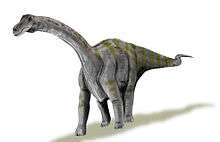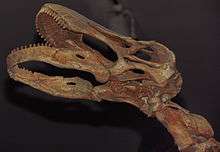Rapetosaurus
| Rapetosaurus Temporal range: Late Cretaceous, 70–66 Ma | |
|---|---|
 | |
| Juvenile skeleton, Field Museum of Natural History | |
| Scientific classification | |
| Kingdom: | Animalia |
| Phylum: | Chordata |
| Class: | Reptilia |
| Clade: | Dinosauria |
| Order: | Saurischia |
| Suborder: | †Sauropodomorpha |
| Clade: | †Neosauropoda |
| Clade: | †Macronaria |
| Clade: | †Titanosauria |
| Clade: | †Lithostrotia |
| Genus: | †Rapetosaurus Curry Rogers & Forster, 2001 |
| Species: | †R. krausei |
| Binomial name | |
| Rapetosaurus krausei Curry Rogers & Forster, 2001 | |
Rapetosaurus is a genus of sauropod dinosaur that lived in Madagascar from 70 to 66 million years ago, at the end of the Cretaceous Period. Only one species, Rapetosaurus krausei, has been identified.
Like other sauropods, Rapetosaurus was a quadrupedal herbivore; it is calculated to have reached lengths of 15 metres (49 ft).
Description

Rapetosaurus was a fairly typical sauropod, with a short and slender tail, a very long neck and a huge, elephant-like body. Its head resembles the head of a diplodocid, with a long, narrow snout and nostrils on the top of its skull. It was a herbivore and its small, pencil-like teeth were good for ripping the leaves off trees but not for chewing.
It was fairly modest in size, for a titanosaur. The juvenile specimen measured 8 metres (26 ft) from head to tail, and "probably weighed about as much as an elephant", according to Kristina Curry Rogers. An adult would have been about twice as long (15 metres (49 ft) in length)[1] which is still less than half the length of its gigantic kin, like Argentinosaurus and Paralititan.
Range
During the early part of the Late Cretaceous all groups of sauropods, with the exception of the titanosaurs, had gone extinct. The titanosaurs were the dominant herbivores of the Late Cretaceous on the southern continents. Their reign was cut short by the Cretaceous–Paleogene extinction event, which killed almost all the dinosaurs about 66 million years ago.
Discovery and naming

The discovery of Rapetosaurus, known by the single species Rapetosaurus krausei marked the first time a titanosaur had been recovered with an almost perfectly intact skeleton, complete with skull. It has helped to clarify some difficult, century-old classification issues, among this large group of sauropod dinosaurs and provides a good baseline for the reconstruction of other titanosaurs that are known only from partial fossilized remains.
The discovery was published in 2001 by Kristina Curry Rogers and Catherine A. Forster in the scientific journal Nature. The nearly-complete skeleton is that of a juvenile and partial remains from three other individuals were also recovered.
The dig uncovered a partial skull (UA 8698, the holotype specimen), another partial skull, a juvenile skeleton missing only a few tail vertebrae, and an unrelated vertebra. The juvenile skeleton, in particular, is the most complete titanosaur skeleton ever recovered and the only one with a head still attached to the body.
The fossilized remains were found in the Mahajanga basin in northwest Madagascar, not far from the port city of Mahajanga. They were recovered from a layer of sandstone known as the Anembalemba Member, which is part of the Maevarano Formation. The rock formation has been dated to the Maastrichtian stage of the late Cretaceous, which means the fossilized bones are about 70 million years old. They were found by a field team from the State University of New York at Stony Brook with the assistance of the local Universite d'Antananarivo. The team leader, David Krause, had been excavating fossils from the site since 1993.
The Madagascar location has produced a large number of significant paleontological discoveries for Krause and his team. As well as dinosaurs, fossils of fishes, frogs, turtles, snakes, crocodiles, birds, and mammals have been unearthed. Significant finds include:
- The skull of Majungasaurus, a large abelisaurid theropod, was discovered in 1996. It is similar to species found in India and Argentina, which indicate that land bridges between the fragments of the former supercontinent of Gondwana still existed in the late Cretaceous, far later than was previously believed. The most likely occurrence was a land bridge allowing animals to cross from South America to Antarctica, and then up to India and Madagascar. Majungasaurus fossils have also been discovered with teeth marks that clearly come from the same species, making it the first dinosaur known to have practiced cannibalism.
- Masiakasaurus is a species of theropod with unusual teeth that stick straight out from its jaw.
- A single, 70-million-year-old marsupial tooth. Madagascar was separated by water when the marsupials first evolved in the northern hemisphere, and there are no current species of marsupial on the island, which has revived the idea that colonies of animals might have somehow crossed vast stretches of water.
Classification
The new species, Rapetosaurus krausei, was described in the August 2, 2001 issue of the scientific journal Nature, by Kristina Curry Rogers (then a graduate student under Catherine Forster and now employed by Macalester College, in St. Paul, Minnesota) and Catherine A. Forster, an Associate Professor at the Department of Anatomical Sciences of the State University of New York at Stony Brook, in Stony Brook, New York.
Rapetosaurus is a member of the family Nemegtosauridae, which is within the unranked taxon Titanosauria.
Titanosaurs are the largest group of sauropods but are poorly represented in the fossil record. Other groups of sauropods, even small families like the brachiosaurids, are known from more complete remains. Until the discovery of Rapetosaurus, the 30 or so genera were represented by just a few bones, a partial skeleton or a skull. The first titanosaur, discovered in 1887, is still only known from a partial skeleton.
This has made it difficult to determine not just the relationship between different genera of titanosaur but even how the titanosaurs are related to other, higher-level groups like the macronarians (the group of "big nostril" sauropods, which include the titanosaurs, the nemegtosaurids and the brachiosaurids). The whole taxon has been used as a dumping ground, with many genera labeled as incertae sedis (belonging to an unknown group), because not enough is known about them to classify them any further.
The Diplodocus-like skull has demonstrated that titanosaur skulls vary more than was previously believed. Most paleontologists believed that titanosaurs had box-like skulls with the nostrils midway up the snout, like the Camarasaurus, but Rapetosaurus has a long, low skull, with the nostrils on the top, similar to Diplodocus. This has allowed genera known only by Diplodocus-like skulls (like Quaesitosaurus and Nemegtosaurus and other nemegtosaurids) to be classified as macronarians rather than in Diplodocoidea.
Analysis of the rest of the skull and the body has also confirmed what was only previous speculation: that titanosaurs are most closely related to the brachiosaurids. A complete skeleton can also serve as a baseline when reconstructing other titanosaurs from limited remains. This is the basis for new, revised estimates of the size of the super-giant titanosaurs.
Etymology
The generic name Rapetosaurus is derived from Rapeto (a giant in Malagasy folklore) and sauros, which is Greek for lizard. The species epithet, krausei, is named after the team leader of the expedition, David W. Krause.
Ontogeny and Growth
A rare specimen of a juvenile Rapetosaurus was uncovered in a museum collection by Kristina Curry Rogers et al and was reported in April, 2016. The specimen was estimated to weigh about 40 kilograms (88 pounds) and was likely between 39-77 days old by the time of its death. At the time of its hatching, the juvenile Rapetosaurus was estimated to be 3.4 kilograms (7.8 pounds) in weight. Based on bone remodeling, the juvenile sauropod was also believed to have been capable of surviving with little to no parental care. Analysis of the bones further revealed the young Rapetosaurus likely starved to death due to Cretaceous Madagascar's harsh droughts.[2]
References
- ↑ Montague, R. (2006). "Estimates of body size and geological time of origin for 612 dinosaur genera (Saurischia, Ornithischia)". Florida Scientist. 69 (4): 243–257.
- ↑ http://news.nationalgeographic.com/2016/04/160421-baby-dinosaur-titanosaur-fossil-independent/?utm_source=Facebook&utm_medium=Social&utm_content=link_fb20160421news-babydinosaurs&utm_campaign=Content&sf24790283=1
Sources
- Kristina Curry Rogers, and Catherine A. Forster. 2004. "The skull of Rapetosaurus krausei (Sauropoda: Titanosauria) from the Late Cretaceous of Madagascar". Journal of Vertebrate Paleontology, 24(1), pages 121–144. Abstract at BioOne
- Kristina Curry Rogers, and Catherine A. Forster. August 2, 2001. "The last of the dinosaur titans: a new sauropod from Madagascar". Nature 412, pages 530–534.
External links
- Paleontology News — Rapetosaurus from the Science Museum of Minnesota.
- Stony Brook Paleontologists Discover New Dinosaur and Name It in Honor of One of Their Own from SUNY-Stony Brook.
- New Dinosaur Species Found from Time for Kids Online.
- Skeleton of New Dinosaur "Titan" Found in Madagascar from National Geographic.
- Dino skull fills knowledge gap from the BBC.
- New Madagascar Dinosaur Discoveries from the T. Rex Museum.
- A press release, from the National Science Foundation, including a reconstruction (illustration).